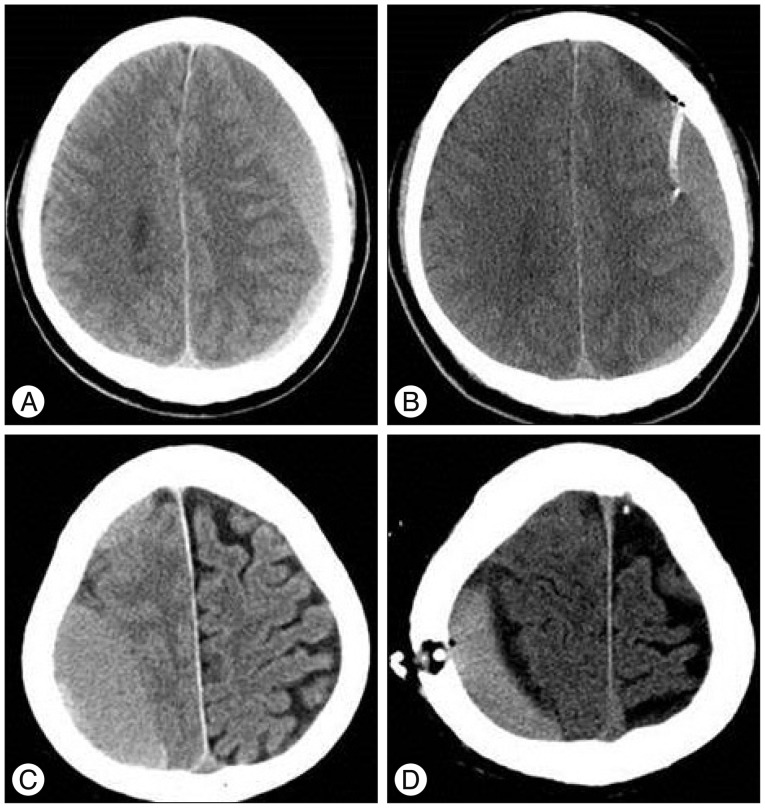J Korean Neurosurg Soc.
2014 Sep;56(3):243-247. 10.3340/jkns.2014.56.3.243.
Comparison of the Indications and Treatment Results of Burr-Hole Drainage at the Maximal Thickness Area versus Twist-Drill Craniostomy at the Pre-Coronal Point for the Evacuation of Symptomatic Chronic Subdural Hematomas
- Affiliations
-
- 1Department of Neurosurgery, Soonchunhyang University Bucheon Hospital, Bucheon, Korea. bumtkim@gmail.com
- KMID: 2339964
- DOI: http://doi.org/10.3340/jkns.2014.56.3.243
Abstract
OBJECTIVE
To analyze the clinical data and surgical results from symptomatic chronic subdural hematoma (CSDH) patients who underwent burr-hole drainage (BHD) at the maximal thickness area and twist-drill craniostomy (TDC) at the precoronal point.
METHODS
We analyzed data from 65 symptomatic CSDH patients who underwent TDC at the pre-coronal point or BHD at the maximal thickness area. For TDC, we defined the pre-coronal point to be 1 cm anterior to the coronal suture at the level of the superior temporal line. TDC was performed in patients with CSDH that extended beyond the coronal suture, as confirmed by preoperative CT scans. Medical records, radiological findings, and clinical performance were reviewed and analyzed.
RESULTS
Of the 65 CSDH patients, 13/17 (76.4%) with BHD and 42/48 (87.5%) with TDC showed improved clinical performance and radiological findings after surgery. Catheter failure was seen in 1/48 (2.4%) cases of TDC. Five patients (29.4%) in the BHD group and four patients (8.33%) in the TDC group underwent reoperations due to remaining hematomas, and they improved with a second operation, BHD or TDC.
CONCLUSION
Both BHD at the maximal thickness area and TDC at the pre-coronal point are safe and effective drainage methods for symptomatic CSDHs with reasonable indications.
Keyword
MeSH Terms
Figure
Cited by 1 articles
-
Clinical Characteristics and Current Managements for Patients with Chronic Subdural Hematoma : A Retrospective Multicenter Pilot Study in the Republic of Korea
Hyuk-Jin Oh, Youngbeom Seo, Yoon-Hee Choo, Young Il Kim, Kyung Hwan Kim, Sae Min Kwon, Min Ho Lee, Kyuha Chong
J Korean Neurosurg Soc. 2022;65(2):255-268. doi: 10.3340/jkns.2021.0138.
Reference
-
1. Almenawer SA, Farrokhyar F, Hong C, Alhazzani W, Manoranjan B, Yarascavitch B, et al. Chronic subdural hematoma management : a systematic review and meta-analysis of 34,829 patients. Ann Surg. 2014; 259:449–457. PMID: 24096761.2. Gjerris F, Schmidt K. Chronic subdural hematoma. Surgery or mannitol treatment. J Neurosurg. 1974; 40:639–642. PMID: 4817809.3. Horn EM, Feiz-Erfan I, Bristol RE, Spetzler RF, Harrington TR. Bedside twist drill craniostomy for chronic subdural hematoma : a comparative study. Surg Neurol. 2006; 65:150–153. discussion 153-154. PMID: 16427409.
Article4. Hwang SC, Im SB, Kim BT, Shin WH. Safe entry point for twist-drill craniostomy of a chronic subdural hematoma. J Neurosurg. 2009; 110:1265–1270. PMID: 19099378.
Article5. Kageyama H, Toyooka T, Tsuzuki N, Oka K. Nonsurgical treatment of chronic subdural hematoma with tranexamic acid. J Neurosurg. 2013; 119:332–337. PMID: 23641825.
Article6. Ko BS, Lee JK, Seo BR, Moon SJ, Kim JH, Kim SH. Clinical analysis of risk factors related to recurrent chronic subdural hematoma. J Korean Neurosurg Soc. 2008; 43:11–15. PMID: 19096538.
Article7. Kudo H, Kuwamura K, Izawa I, Sawa H, Tamaki N. Chronic subdural hematoma in elderly people : present status on Awaji Island and epidemiological prospect. Neurol Med Chir (Tokyo). 1992; 32:207–209. PMID: 1378564.
Article8. Lee JY, Kim BT, Hwang SC, Im SB, Shin DS, Shin WH. Indications and surgical results of twist-drill craniostomy at the pre-coronal point for symptomatic chronic subdural hematoma patients. J Korean Neurosurg Soc. 2012; 52:133–137. PMID: 23091672.
Article9. Markwalder TM, Steinsiepe KF, Rohner M, Reichenbach W, Markwalder H. The course of chronic subdural hematomas after burr-hole craniostomy and closed-system drainage. J Neurosurg. 1981; 55:390–396. PMID: 7264730.
Article10. Ramnarayan R, Arulmurugan B, Wilson PM, Nayar R. Twist drill craniostomy with closed drainage for chronic subdural haematoma in the elderly : an effective method. Clin Neurol Neurosurg. 2008; 110:774–778. PMID: 18538920.
Article11. Stanišić M, Hald J, Rasmussen IA, Pripp AH, Ivanović J, Kolstad F, et al. Volume and densities of chronic subdural haematoma obtained from CT imaging as predictors of postoperative recurrence : a prospective study of 107 operated patients. Acta Neurochir (Wien). 2013; 155:323–333. discussion 333. PMID: 23229873.
Article12. Suzuki J, Takaku A. Nonsurgical treatment of chronic subdural hematoma. J Neurosurg. 1970; 33:548–553. PMID: 5479493.
Article13. Tabaddor K, Shulmon K. Definitive treatment of chronic subdural hematoma by twist-drill craniostomy and closed-system drainage. J Neurosurg. 1977; 46:220–226. PMID: 833639.
Article14. Weigel R, Hohenstein A, Schlickum L, Weiss C, Schilling L. Angiotensin converting enzyme inhibition for arterial hypertension reduces the risk of recurrence in patients with chronic subdural hematoma possibly by an antiangiogenic mechanism. Neurosurgery. 2007; 61:788–792. discussion 792-793. PMID: 17986940.
Article
- Full Text Links
- Actions
-
Cited
- CITED
-
- Close
- Share
- Similar articles
-
- Erratum to "Comparison of the Indications and Treatment Results of Burr-Hole Drainage at the Maximal Thickness Area versus Twist-Drill Craniostomy at the Pre-Coronal Point for the Evacuation of Symptomatic Chronic Subdural Hematomas" by Kim GH, et al. (J Korean Neurosurg Soc 56 : 243-247, 2014)
- Twist-Drill or Burr Hole Craniostomy for Draining Chronic Subdural Hematomas: How to Choose It for Chronic Subdural Hematoma Drainage
- Indications and Surgical Results of Twist-Drill Craniostomy at the Pre-Coronal Point for Symptomatic Chronic Subdural Hematoma Patients
- Burr Hole Drainage versus Small Craniotomy of Chronic Subdural Hematomas
- One vs. Two Burr Hole Craniostomy in Surgical Treatment of Chronic Subdural Hematoma


